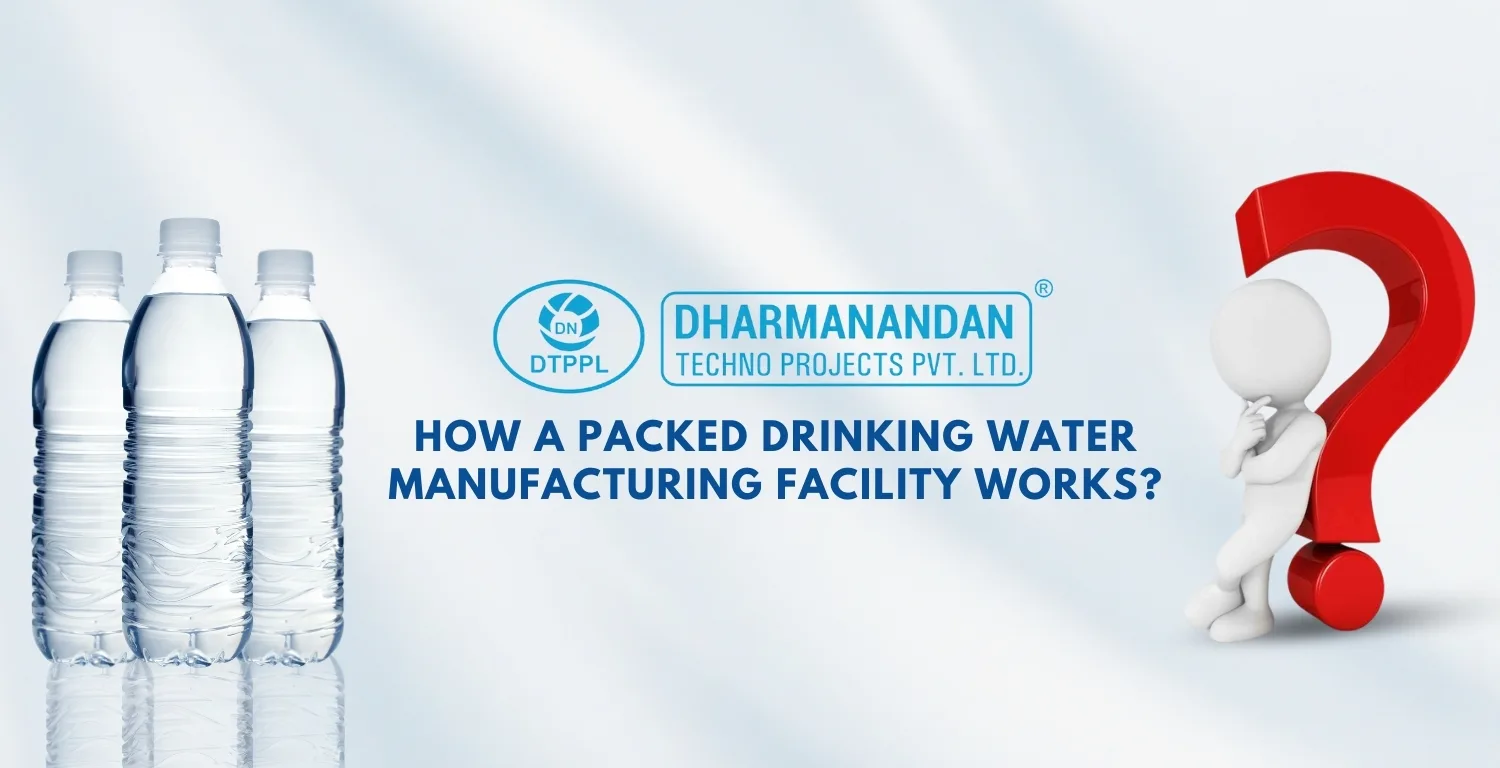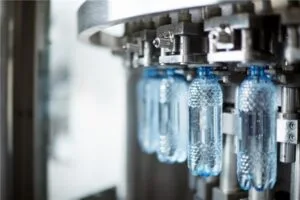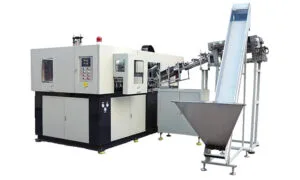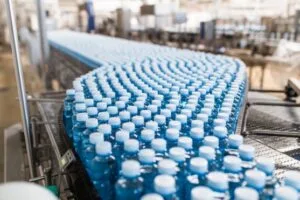
Table of Contents
How does packed drinking water manufacturing facility work?
December 29, 2022
The demand for packaged drinking water is multiplying each year. With the advent of technology and automation, the packaging of mineral water production lines today has become entirely automated and is heading towards sustainability.
Let us know how does packed drinking water manufacturing facility actually work?
The bottled water manufacturing process illustrates the stages it undergoes from filtering to the final packaged bottle. The flow chart of its manufacturing process is as follows:
Water Sourcing and Treatment
Content Expansion:
Water sourcing is the first and most crucial step in bottled water manufacturing. The water used in bottling can come from multiple sources:
- Source Water: This includes underground water (borewells), municipal supplies, or surface water bodies like rivers and lakes.
- Pre-treatment: The initial filtration step removes large particles such as sediments, dirt, and debris.
- Multi-stage Filtration:
- Sand filtration: Removes large suspended particles and turbidity.
- Activated carbon filtration: Eliminates chlorine, odors, and organic impurities.
- Microfiltration: Captures smaller impurities and microorganisms, improving the water’s clarity and purity.
- Purification Methods:
- Reverse Osmosis (RO): Forces water through a semi-permeable membrane to remove dissolved salts, bacteria, and viruses.
- Distillation: Boils water to produce steam, which is condensed back into water, leaving impurities behind.
- UV Sterilization: Uses ultraviolet light to eliminate harmful microorganisms.
- Ozonation: Injects ozone gas into water to purify and improve taste.
- Mineralization: In mineral water bottling, essential minerals like calcium and magnesium are added to enhance taste and health benefits.
Phase 1
Water Treatment

-Raw Water Pump
-Mechanical Filter
-Activated carbon filters
-Water softener system
-Precision filters
-Reverse osmosis system
-Ozone system
-UV light sterilizer
Phase 2
Filling and packaging

-Air conveyor
-Water bottling machine
-Cap feeder machine
-Bottle blow dryer
-Laser coding machine
-Self-adhesive labelling machine
-Shrink sleeve label machine
-Shrink wrap machine
-Pallet wrapping machine
Water Filling, Capping, and Sealing
The filling and capping stages are crucial for maintaining the hygiene and quality of the water:
- Sterile Environment: The filling process takes place in a sterile environment, ensuring that the water doesn’t get contaminated by outside factors.
- Filling Machines: Modern production lines use 3-in-1 filling machines that integrate the processes of rinsing, filling, and capping into one automated system. This reduces the chances of contamination and improves efficiency.
- Gravity Filling Systems: Used primarily for still water, gravity-based filling systems are simple and effective for precise control over water levels in bottles.
- Controlled Filling for Sparkling Water: Carbonated water requires controlled filling to maintain carbonation. Special equipment ensures that the pressure inside the bottle matches the carbonation level.
- Sealing: Once the bottles are filled, they are sealed with screw caps or press-on lids to keep them airtight and fresh, preventing any leaks during transportation.
Labeling and Packaging
The final stage of the manufacturing process focuses on labeling and packaging the bottles for sale:
- Automated Labeling: Once bottles are filled and sealed, they move to automated labeling machines. These machines apply branded labels with important details such as ingredients, expiration dates, and regulatory certifications.
- Labeling Methods: Heat shrink labels are commonly used for a tight fit around the bottle, while adhesive stickers are applied to the bottle’s surface for a more cost-effective approach.
- Packaging: After labeling, the bottles are grouped into cartons or trays. Automated systems such as case packers and palletizers sort and pack the bottles, preparing them for distribution.
- Packaging Materials: While PET plastic is the most common material used for packaging, HDPE (High-Density Polyethylene) and PP (Polypropylene) are also used. For premium products, bottles made from glass or aluminum are preferred to improve the product’s perceived quality.
Quality Control and Regulations
Ensuring the quality and safety of bottled water is paramount. Stringent regulations and regular testing ensure that consumers receive safe, clean water.
- Regulatory Compliance: Bottled water manufacturers are required to comply with regulations set by FSSAI (Food Safety and Standards Authority of India) and BIS (Bureau of Indian Standards). For example, IS 14543 specifies the standards for packaged drinking water.
- Testing: Regular testing is conducted at multiple stages of the process:
- Source water: Ensures the raw water is free of contaminants.
- In-process water: Checks during the filtration and purification stages.
- Final product: Ensures that the finished bottled water meets hygiene and purity standards.
- Environmental Responsibility: With growing concerns over plastic waste, companies are focusing on sustainable packaging, promoting recycling, and supporting groundwater recharge initiatives to ensure environmental sustainability.
Phase 3
Bottle Blowing

-Automatic bottle blow molding machine
-Semi-automatic blow molding machine
-Air compressor
-Water chiller
-Air dryer
-Air filter
-Mold temperature controller
-Air storage tank
Water must be free of any contaminants that deteriorate its quality, reduce its shelf life, and pose a threat to consumers. Hence, it is first filtered through various machines.
To maintain the quality of water, a reliable container is essential. The air used in the bottle blower to turn the pre-forms into the final PET bottle must be free of toxins or contaminants. Also, the water used to rinse PET bottles must be free of contaminants; its filtration ensures good quality of the bottles prior to filling. Bottle blowing is undertaken in phase 3 using PET bottles, where it is molded using necessary temperature and made eligible to store water for a stipulated time.
DTPPL has been the leader in the water plant and mineral water bottle packaging industry since more than a decade. We aim to deliver the best and most tested bottled water production solutions that help reduce manufacturing costs in the blowing process, bottle design, and packaging bottle durability while enhancing bottling quality.
Our packed water manufacturing process:

– Reduces costs with flexible and avails lightweight packaging solution
– We have High-speed, high-convenience transmission system
– Possesses High resource consumption rate, has low energy emission reduction, and works towards sustainable development
– All our machines are automated and laded with high-yield capacity that cater to your production needs and delivers desired output on time.
Bottle Manufacturing and Blowing
In the manufacturing process of bottled water, PET bottle blowing plays a pivotal role. PET (Polyethylene Terephthalate) is the most common material used for making water bottles due to its durability and recyclability.
- PET Bottle Blowing: Bottles are produced on-site using PET preforms (plastic tubes that are heated and molded). This reduces costs associated with buying pre-made bottles and ensures that the bottles fit the brand’s specific design requirements.
- Preform Heating and Molding: Preforms are heated and then blown into molds to take shape. This process allows for high-volume production while maintaining the structural integrity of the bottles.
- Benefits of On-site Manufacturing: Producing bottles on-site eliminates supply chain delays, reduces costs, and allows for the customization of bottle designs. It also ensures high-quality production, as the process is controlled in-house.
Environmental Responsibility and Sustainability
Sustainability is becoming increasingly important in the bottled water industry, and manufacturers are focusing on reducing their environmental impact.
- Eco-Friendly Packaging: Many companies are moving towards recycled PET bottles or using alternative, biodegradable materials. This helps reduce the reliance on virgin plastic and encourages consumers to recycle.
- Water Conservation: Water manufacturing plants are investing in groundwater recharge programs and improving water usage efficiency during production to minimize waste.
- Sustainable Practices: There’s a strong push towards energy-efficient machinery, reducing energy consumption during production, and minimizing carbon footprints.
DTPPL is an ISO certified Mineral Water Plant Supplier, leading in Mineral Water Bottle Making Machine, and PET Blow Moulding Machine.
Connect with us today for all water plant & water bottle manufacturing related queries & set up.
